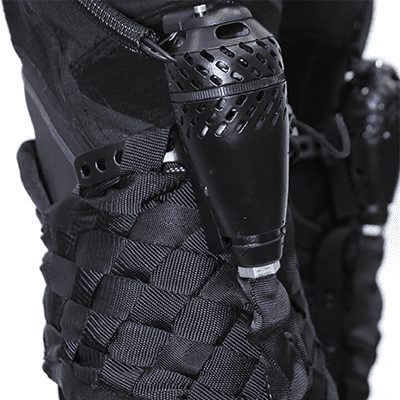Leveraging flexible components and under-actuated architecture to enhance performance and mitigate injury risks from dynamic activities.
THE CHALLENGE
The human body is complex and can only endure a finite amount of stress. There are numerous professions that require workers to engage in strenuous activities or carry large amounts of weight. Over time, these conditions can lead to injuries and diminished performance.
THE SOLUTION
Researchers at SRI International developed SuperFlex™ technology. It’s a soft biofidelic actuated exosuit that augments the musculoskeletal system for performance and strength enhancement and assistance to overcome or prevent damage from injury or disease.
The human body is extremely complex and can only handle a finite amount of stress. Even with extensive training, humans often experience injuries when engaging in strenuous activities. An area where this rings true is the military sector.
To help reduce injuries sustained by soldiers, while also enabling them to maintain peak performance, researchers at SRI worked to develop exoskeleton technology for the DARPA-funded program known as Warrior Web. This program sought to develop the technologies required to prevent and reduce musculoskeletal injuries caused by dynamic events typically found in the warfighter’s environment.

After the conclusion of the Warrior Web program, SRI researchers continued exploring ways technology could be used to make a difference in society at large. The answer was to develop a way to provide power assist to the lower back and hips coordinated with body motion. Doing so would help people overcome age-related mobility limitations dramatically effect independence, quality of life and cost of care, and the broad population of individuals who have pain and fatigue from injury, work-related body stress, or chronic disabilities.
This led to the creation of a soft, comfortable and lightweight robotic exosuit known as SuperFlex. It’s a wearable “exosuit” that augments the musculoskeletal system for performance, strength enhancement, and assistance to overcome or prevent damage from injury or disease.
In addition to SuperFlex, SRI researchers developed solutions such as:
- FlexDrive™: Lightweight, conformal, high-torque and efficient exomuscles that assist the body’s own muscles in a very natural way.
- FlexGrip™: Flexible, comfortable load transfer between the suit and the body.
- e-Flex™: Lightweight, flexible electrostatically clutched springs act as variable stiffness “exotendons” to adaptively store energy and limit range of motion to prevent injury or fatigue.
- FlexControl™: Adaptive state-based controller delivers “super reflexes”, adjusts to varying terrain, and uses an intuitive digital user interface.
After further refining these technologies, former Director of Robotics at SRI, Rich Mahoney, left SRI to spin off Seismic. His company is now working to combine apparel and discrete robotics in order to create clothing that helps individuals reach their full physical potential.
With SRI technology at its core, Seismic added enhancements such as added strength at the back, hips, thighs. This enables wearers to experience less fatigue, greater stability and feeling stronger in activities throughout their day. Seismic suits support the body’s core by providing up to 30 watts of power to each hip and the lower back to support sitting, standing, lifting, carrying and a range of other activities.
To learn more about Seismic’s current status, please email inquiries@myseismic.com



